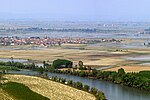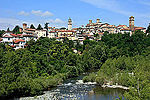Alessandria railway station
AlessandriaBuildings and structures in AlessandriaRailway stations in Italy opened in 1850Railway stations in Piedmont

Alessandria railway station (Italian: Stazione di Alessandria) serves the city and comune of Alessandria, in the Piedmont region, northwestern Italy. Opened in 1850, it forms part of the Turin–Genoa railway, and is also a junction for six other lines, to Chivasso, Piacenza, Novara, Pavia, Cavallermaggiore, Ovada and San Giuseppe di Cairo. The station is currently managed by Rete Ferroviaria Italiana (RFI). However, the commercial area of the passenger building is managed by Centostazioni. Train services are operated by Trenitalia. Each of these companies is a subsidiary of Ferrovie dello Stato (FS), Italy's state-owned rail company.
Excerpt from the Wikipedia article Alessandria railway station (License: CC BY-SA 3.0, Authors, Images).Alessandria railway station
Piazza Eugenio Curiel, Alessandria
Geographical coordinates (GPS) Address External links Nearby Places Show on map
Geographical coordinates (GPS)
| Latitude | Longitude |
|---|---|
| N 44.909166666667 ° | E 8.6063888888889 ° |
Address
Alessandria
Piazza Eugenio Curiel
15121 Alessandria
Piedmont, Italy
Open on Google Maps







